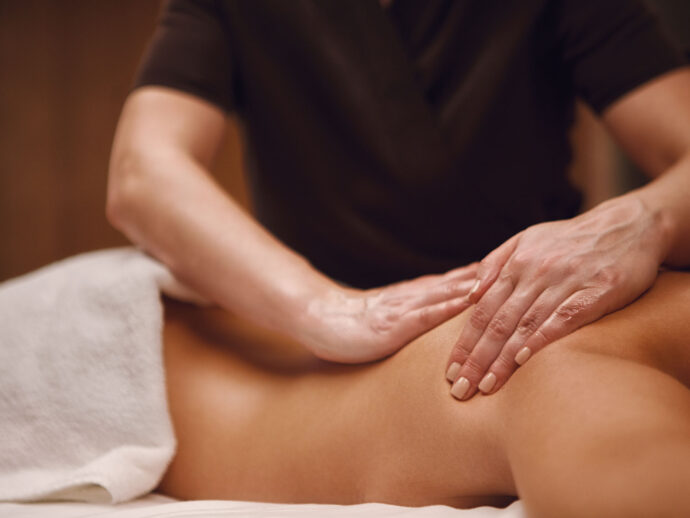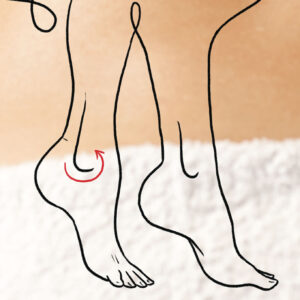
What better way to relax with your special person than to share a relaxing massage? Find the magic with these simple massage routines.
There’s nothing quite like a session with a registered massage therapist. But what if we could recreate some of that muscle-easing magic at home? We may never match the skill of a trained professional, but therapeutic touch is something we can all practise and enjoy.
Partner massage can offer comfort, relieve stress, and build communication and connection. And don’t fret; we’re not talking about long, complicated routines—just some simple ways to share the love. Give these simple rubs a try.
Our experts
- Colleen Moser, RMT and co-owner of Cambie Village Massage Therapy in Vancouver
- Aysha Revell, RMT at Turning Point Wellness Centre in Steveston, BC
- Lisa Schneider, RMT at Connect Health Centre for Integrative Medicine in Vancouver
- Justine Sones, RMT formerly at Urban Healing in Vancouver
Lower leg, ankle, and foot

- Glide up the entire calf from the ankle to knee. Maintain a firm but gentle pressure.
- In a circular motion, rub around the medial and lateral malleoli (the bony bumps that stick out on either side of the ankle) before moving on to the foot.
- Apply upward circular strokes around the sides of the heel and where the heel meets the arch, using the knuckle of your thumb or first finger if your partner wants more pressure.
- Explore the arch with firm but gentle strokes toward the heel (firm pressure helps avoid tickling). Massage the outer edges of the foot, then apply circular motions to the ball of the foot, working toward the creases of the toes.
- Grasp the base of each toe and work your way around on all sides toward the tip. Take your time and contact each area front and back.
Dos and don’ts for your partner massage
- Don’t massage areas of pain; inflammation; or broken, bruised, or fragile skin.
- Do ensure that you and your partner are comfortable. Support limbs to be massaged with pillows, blankets, or yoga bolsters. Position yourself to limit strain on your back and neck.
- Don’t perform scalp massage on children under two years of age.
- Do start gently and work into deeper pressure. Ask if the pressure feels good and adjust accordingly.
- Don’t press on bony areas, especially the spine. It can be uncomfortable and potentially cause injury.
- Do start with larger areas, using at least five to 10 strokes on each section, and work your way to smaller areas.
- Don’t massage the ankles, feet, wrists, or hands of a pregnant woman without consulting a practitioner.
- Do start closest to the body when massaging a limb, gradually working toward the fingers or toes.
- Do direct the pressure back toward the heart.
Shoulders and arms

- Stand behind your seated partner. Place your cupped hands on their shoulders and begin compressions: pressing into the muscle, then releasing. Move from the shoulders down the arms and forearms, and give the hands a squeeze too.
- Return to the shoulders, and slowly move your fingers from the base of the neck out to the shoulder with gentle circular kneading. Continue this movement, going as deep as your partner finds therapeutic.
- Massage the tops of the shoulders by pressing your knuckles into the upper trapezius muscle and moving outward toward the shoulders.
- Now move in front of or beside your partner. Hold your partner’s wrist with one hand, and with the other, make long fluid strokes (effleurage) from the wrist toward the shoulder, and carry those strokes back down to the wrist. Finish the final stroke at the shoulder, encouraging the blood flow back to the heart. Place your hand on the top of the arm, squeezing and kneading the muscles (petrissage) moving down into the forearm.
- Continue holding your partner’s wrist, and use your other hand to massage from the wrist up to the elbow and back down again, concentrating on both sides of the forearm.
- End the massage on the arm with a few full strokes back up to the shoulder, or continue to the hand massage (below). Repeat on the other arm.
Scalp and ears

Note: This massage is best performed without oil.
- Start at the earlobe and, using gentle squeezing and light, circular motions, work your way up the ear and back down again.
- Using your finger pads, rub the scalp with firm pressure, getting all the way to the edge of the hairline. Make sure to contact the scalp with all your fingertips and try to get every area—especially the occipital ridge (at the base of the skull) and the temples. You can also combine with a shampoo for the ultimate in pampering!
Oil: Slip versus grip
Oil reduces friction, which makes a massage more comfortable. Our experts recommend using natural oils, such as grapeseed, apricot kernel, or jojoba oil. Olive and coconut oils can also be used. Start with a very small amount and add more if needed. For a hand or foot massage, you can even use a light lotion.
Forearms, wrists, and hands

- Begin with gentle but firm strokes along the entire forearm toward the elbow joint.
- Hold the wrist and hand, and slowly roll the wrist around a few times. Next, place your thumbs in your partner’s palm and make a spreading motion from the centre of the palm outward, also from near the wrist, out toward the fingers. Press into the muscles between the bones in the hand, especially the web between the first finger and thumb.
- Take the base of each finger one at a time and massage all sides up toward the tip, gently flexing the knuckle joints and stretching the fingers apart.
- Return to the palm, reversing the order until you are back at the wrist. Repeat on the other hand.



































